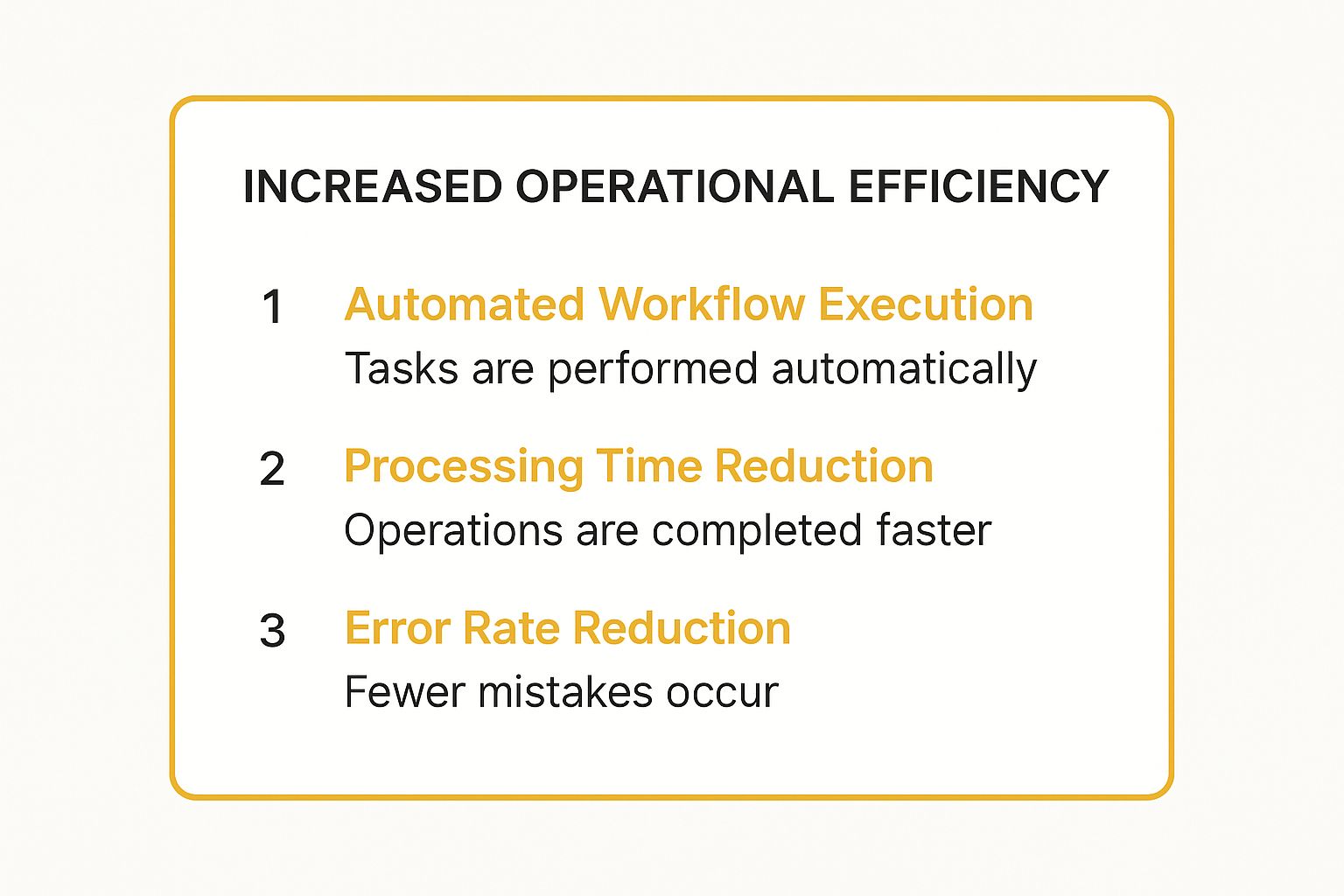In a competitive market, maintaining an edge requires more than hard work-it demands intelligent operational strategies. Business process automation (BPA) has shifted from a niche technology to a core component for organizations aiming to boost efficiency, slash costs, and fuel growth. By systematically automating routine, rule-based tasks, businesses can unlock substantial value and empower their teams to focus on high-impact, strategic initiatives that drive innovation. This shift is crucial for sustainable success and scalability.
This article provides an in-depth exploration of the primary business process automation benefits that deliver tangible returns. We will move beyond theory and delve into specific examples, practical tips, and actionable insights to demonstrate how embracing automation is essential for thriving in the modern economy. For a comprehensive look at how automation transforms financial operations, detailing specific advantages like increased efficiency and reduced errors, explore the 8 key accounts payable automation benefits for a focused case study.
From enhancing operational agility to improving data-driven decision-making, the following eight benefits offer a clear roadmap for leveraging technology to achieve your strategic goals. We will cover how each advantage directly contributes to a stronger, more resilient, and more profitable business model.
1. Increased Operational Efficiency
One of the most immediate and impactful business process automation benefits is a dramatic increase in operational efficiency. At its core, automation streamlines workflows by taking over manual, repetitive tasks that consume valuable employee time. This allows your organization to process significantly more work in less time and with greater accuracy, directly boosting productivity.
How Automation Drives Efficiency
Automation software executes predefined rules and sequences without fatigue or distraction. This means tasks like data entry, invoice processing, and report generation are completed consistently and instantly. For instance, JP Morgan famously implemented a system to analyze commercial loan agreements, reducing a task that once took 360,000 human hours annually down to mere seconds. This frees up your skilled team to focus on strategic initiatives, problem-solving, and creative work that truly drives business growth.
Key Efficiency Gains at a Glance
The following summary box highlights the three primary ways automation enhances operational efficiency.

As the infographic illustrates, the core advantages lie in executing workflows faster, cutting down processing times, and minimizing human error. These interconnected benefits create a powerful cycle of continuous improvement and resource optimization.
Practical Implementation Steps
To achieve these gains, start by identifying high-volume, rule-based processes within your operations.
- Map Existing Workflows: Before automating, create a detailed map of the current process to identify bottlenecks and areas for improvement.
- Start Small: Begin with a single, straightforward process, like accounts payable data entry, to demonstrate value and minimize disruption.
- Monitor Key Metrics: Continuously track metrics such as processing time per item, error rates, and employee time saved to measure ROI and refine the system.
This video from IBM provides a great overview of how automation works in practice to create more efficient business operations.
2. Significant Cost Reduction
Beyond improving speed, one of the most compelling business process automation benefits is a substantial reduction in operational costs. Automation achieves this by directly lowering labor expenses, eliminating costly human errors that require rework, and optimizing the use of company resources. This financial impact is often swift, with many organizations realizing a positive return on their investment within the first 6 to 18 months.
How Automation Drives Savings
Automated systems handle high-volume, rule-based tasks more economically than human employees. Tasks like invoice matching, payroll processing, and inventory management are executed with precision, freeing capital from manual labor budgets. For instance, Walmart’s supply chain automation led to over $1 billion in logistics savings, while General Electric cut procurement costs by 20% by automating its sourcing processes. This strategic reallocation of funds allows your business to invest in growth areas rather than just maintaining current operations.
Key Cost-Saving Areas at a Glance
The following summary box highlights the three primary areas where automation delivers significant financial returns.

As the infographic illustrates, automation delivers tangible savings by decreasing manual labor requirements, cutting down on expenses related to error correction, and reducing overall operational overhead. These factors combine to create a leaner, more financially resilient organization. You can learn more about how AI automation for businesses drives these specific outcomes and boosts your bottom line.
Practical Implementation Steps
To maximize cost reduction, it's crucial to approach automation with a clear financial strategy.
- Focus on High-Cost Processes: Identify the manual tasks that consume the most labor hours or are most prone to expensive errors. These are your prime candidates for initial automation.
- Calculate Total Cost of Ownership (TCO): Factor in all costs, including software licensing, implementation, training, and ongoing maintenance, to ensure a clear view of your ROI.
- Track Cost-Saving Metrics: Continuously monitor metrics like cost-per-transaction, labor hours saved, and error reduction rates to quantify the financial impact of your automation initiatives.
3. Enhanced Accuracy and Error Reduction
Another one of the core business process automation benefits is a significant improvement in accuracy by nearly eliminating human error from routine operations. Manual processes, especially those involving data entry or complex calculations, are inherently prone to mistakes. Automated systems, however, execute tasks based on predefined rules with perfect consistency every time, ensuring high-quality outputs and reducing the costly downstream effects of errors.
How Automation Drives Accuracy
Automation software operates without fatigue or distraction, meticulously following its programming. This consistency is crucial for tasks where even minor mistakes can have major consequences. For example, a misplaced decimal in an invoice or a wrong entry in a customer database can lead to financial loss and damaged relationships. Automation ensures data integrity across different systems, performs flawless calculations, and validates information against established rules. Robotic Process Automation (RPA) leader UiPath has demonstrated that automated invoice processing can achieve up to 99.5% accuracy, a stark contrast to the typical 85% accuracy of manual processing.
Practical Implementation Steps
To leverage automation for error reduction, a structured approach focused on quality is essential.
- Implement Robust Validation Rules: Configure your automation tools with strict validation rules that automatically flag or reject data that doesn't meet specific criteria.
- Create Comprehensive Test Scenarios: Before deployment, rigorously test the automation against a wide range of scenarios, including edge cases and potential failure points, to ensure it behaves as expected.
- Design Proper Exception Handling: Build clear pathways for handling exceptions. The system should know precisely what to do when it encounters data it cannot process, such as flagging it for human review instead of making an incorrect assumption.
- Monitor Accuracy Metrics Continuously: Track key performance indicators (KPIs) like error rates and data validation failures to measure the automation's effectiveness and identify areas for refinement. These steps are fundamental to any successful rollout and align with key quality assurance best practices.
4. Improved Customer Experience
Another of the key business process automation benefits is the ability to significantly enhance the customer experience. Automation elevates service delivery by providing faster response times, 24/7 availability, and highly consistent interactions across all channels. By automating routine inquiries and processes, businesses can ensure customers receive immediate attention and uniform service quality, which is crucial for building loyalty and satisfaction.

How Automation Elevates Customer Service
Automated systems like chatbots, AI-powered support tickets, and instant order confirmations handle customer needs without delay. For example, American Express uses chatbots to resolve 65% of customer inquiries instantly, freeing human agents for complex issues. This dual approach means customers get quick answers for simple questions and expert help for nuanced problems, creating a seamless and efficient support structure. This level of responsiveness is a powerful differentiator in a competitive market.
Key Customer Experience Gains at a Glance
As the infographic highlights, the core advantages are faster resolutions, consistent service delivery, and the ability to offer support around the clock. These elements work together to meet and exceed modern customer expectations for speed and reliability. For organizations looking to strengthen their customer relationships, learning more about how to improve customer experience is a vital step.
Practical Implementation Steps
To leverage automation for better customer interactions, focus on creating intelligent and user-friendly systems.
- Design Customer-Centric Workflows: Map out the customer journey and identify points where automation can remove friction, such as automated status updates or instant request confirmations.
- Provide an Easy Escalation Path: Ensure that customers using an automated system can seamlessly connect with a human agent if their issue is complex or requires a personal touch.
- Personalize Automated Interactions: Use customer data to tailor automated communications. Addressing customers by name and referencing their history makes the experience feel more personal and less robotic.
5. Enhanced Compliance and Audit Capabilities
In heavily regulated industries, maintaining compliance is not just a best practice; it's a requirement for survival. One of the most critical business process automation benefits is the ability to strengthen compliance management and simplify auditing. Automation enforces rules consistently, creating a reliable framework that significantly reduces the risk of costly human error and regulatory penalties.
How Automation Drives Compliance
Automated systems are designed to operate within a strict set of predefined rules that align with regulatory standards. This ensures that every transaction, record, and process step adheres to legal and corporate policies without exception. For example, HSBC’s automated Anti-Money Laundering (AML) system screens 100 million transactions daily, a scale impossible for manual teams. This systematic enforcement creates an immutable, timestamped digital record of all activities, providing a transparent and easily accessible audit trail for regulators.
Key Compliance Gains at a Glance
The following summary box highlights the three primary ways automation bolsters compliance and auditing.
As the infographic illustrates, the core advantages lie in enforcing policies consistently, generating automatic audit trails, and reducing overall compliance risk. These elements work together to build a robust, auditable operational environment that can withstand regulatory scrutiny.
Practical Implementation Steps
To leverage automation for better compliance, start by focusing on processes with significant regulatory oversight.
- Map Regulatory Requirements: Begin by thoroughly documenting all compliance obligations, from GDPR and SOX to industry-specific mandates, and map them to your internal processes.
- Implement Real-Time Monitoring: Configure your automation tools to send instant alerts for any deviations from compliance rules, allowing for immediate corrective action.
- Automate Documentation: Set up systems to automatically generate and store detailed documentation for every automated task, ensuring a comprehensive audit trail is always ready for review.
This video from Deloitte explains how organizations can use automation to transform their compliance functions and manage regulatory risk more effectively.
6. Superior Scalability and Flexibility
One of the most powerful business process automation benefits is the ability to achieve superior scalability and flexibility. Automation provides a framework for growth, allowing your organization to handle dramatically increased workloads and transaction volumes without a proportional increase in headcount or resources. This elastic capacity is a key differentiator in a fluctuating market.
How Automation Enables Scaling
Automated systems are designed to process tasks based on predefined logic, not on the availability of human staff. This means they can handle a sudden influx of orders, customer inquiries, or data processing demands without faltering. Unlike manual processes that hit a ceiling based on employee capacity, automated workflows can scale almost infinitely with minimal incremental cost. For example, Netflix’s automated content delivery network seamlessly scales to serve over 230 million global subscribers, a feat impossible with manual oversight. This ensures consistent performance whether you're serving ten clients or ten million.
Key Scalability Gains at a Glance
The ability to grow without friction is paramount. Automation supports this by allowing businesses to expand operations, enter new markets, and adapt to seasonal demand spikes efficiently and cost-effectively.
Key Insight: Automation decouples business growth from linear hiring. Instead of asking "how many people do we need to hire to handle this growth?" the question becomes "how can we adjust our automated workflows to absorb the new volume?" This fundamental shift changes your entire operational and financial model for scaling.
The core advantages lie in handling increased transaction volume without performance degradation, adapting quickly to market changes, and maintaining low operational costs during expansion.
Practical Implementation Steps
To build scalable automation, you must design with future growth in mind from the very beginning.
- Design for Scalability: When creating automated workflows, avoid hard-coded limits. Build processes that can handle variable loads and are not tied to specific user counts or transaction numbers.
- Use Cloud-Based Platforms: Leverage cloud-based automation tools like those offered by Amazon Web Services (AWS) or Microsoft Azure. These platforms provide auto-scaling capabilities, automatically allocating more resources during peak times and scaling down to save costs during lulls.
- Plan for Peak Load: Identify potential peak scenarios, such as a holiday sales rush or a major marketing campaign launch. Test your automated systems against these simulated loads to ensure they can perform under pressure without bottlenecks.
7. Better Data Analytics and Decision Making
One of the most transformative business process automation benefits is the ability to unlock superior data analytics, leading to smarter, more strategic decision making. Manual processes often create fragmented, unstructured, and error-prone data that is difficult to analyze. Automation solves this by systematically capturing clean, structured, and real-time data at every stage of a workflow.

How Automation Powers Insights
Automated systems act as diligent record-keepers, logging every action, timestamp, and outcome without fail. This creates a rich repository of operational intelligence that reveals performance trends, bottlenecks, and opportunities for optimization. For example, FedEx's automated tracking systems generate immense volumes of data, which is then used for predictive delivery optimization and route planning. Similarly, Starbucks leverages automated sales data to fine-tune inventory levels, reportedly reducing waste by up to 30% while ensuring product availability.
Key Data-Driven Advantages at a Glance
This consistent flow of high-quality data provides a clear view into your operations, enabling you to move from guesswork to data-backed strategy. The primary advantages include enhanced visibility into process performance, the ability to identify and resolve inefficiencies quickly, and the power to forecast future trends with greater accuracy. This data-centric approach, popularized by tools like Microsoft Power BI and Tableau, forms the foundation for continuous improvement and a significant competitive edge.
Practical Implementation Steps
To leverage automation for better decision making, focus on turning raw data into actionable intelligence.
- Define Key Metrics Upfront: Before automating, determine the key performance indicators (KPIs) you want to track, such as cycle time, error rates, or resource utilization.
- Implement Real-Time Dashboards: Integrate your automation software with business intelligence (BI) tools to create real-time monitoring dashboards that visualize your KPIs.
- Establish a Feedback Loop: Use the insights generated from your data to continuously refine and optimize your automated processes, creating a cycle of improvement.
8. Enhanced Employee Satisfaction and Productivity
One of the most profound business process automation benefits is its positive impact on your workforce. By automating mundane, repetitive tasks, you empower employees to shift their focus from tedious manual work to more strategic, creative, and fulfilling responsibilities that require uniquely human skills like critical thinking, empathy, and innovation. This transition leads directly to higher job satisfaction and engagement.
How Automation Drives Satisfaction
Automation software acts as a digital assistant, handling the high-volume, low-value work that often leads to burnout and disengagement. Tasks like copying data between systems, generating standard reports, or sending routine follow-up emails are taken off employees' plates. For example, Microsoft saw a 15% increase in employee satisfaction scores after implementing automation tools that freed up their team for higher-value activities. This allows your human capital to be utilized for work they find more meaningful, boosting morale and retention.
Key Satisfaction Gains at a Glance
The primary ways automation enhances the employee experience are by removing monotony, creating opportunities for growth, and enabling a focus on impactful work. When employees feel their contributions are valuable and their skills are being developed, their overall productivity and loyalty to the company increase significantly. This creates a more innovative and motivated work environment.
Practical Implementation Steps
To successfully use automation to boost employee satisfaction, clear communication and employee involvement are crucial.
- Communicate the "Why": Clearly explain that automation is a tool to augment their roles, not replace them. Frame it as an initiative to eliminate boring work and create more interesting opportunities.
- Provide Reskilling Opportunities: Offer training and development programs to help employees acquire new skills in areas like data analysis, strategic planning, or managing the automation tools themselves.
- Involve Employees in Design: Ask your team to identify the most tedious parts of their jobs that are ripe for automation. Involving them in the process gives them ownership and ensures the solutions solve real-world frustrations.
Business Process Automation Benefits Comparison
| Aspect | Increased Operational Efficiency | Significant Cost Reduction | Enhanced Accuracy and Error Reduction | Improved Customer Experience | Enhanced Compliance and Audit Capabilities | Superior Scalability and Flexibility | Better Data Analytics and Decision Making | Enhanced Employee Satisfaction and Productivity |
|---|---|---|---|---|---|---|---|---|
| Implementation Complexity 🔄 | Moderate setup and process redesign required | High upfront investment needed | Requires precise rule definition | Moderate; needs customer-centric workflow design | High; deep regulatory knowledge needed | High; infrastructure and coordination needed | Moderate; analytics expertise required | Moderate; change management and reskilling needed |
| Resource Requirements ⚡ | Automation tools, workflow mapping | Technology investment, ongoing maintenance | Validation systems, audit tools | Multichannel platforms, AI/chatbot tech | Compliance monitoring software and audit systems | Scalable cloud infrastructure | BI tools, data capture systems | Training resources, employee engagement initiatives |
| Expected Outcomes 📊 | Time savings, fewer errors, increased throughput | Reduced labor and overhead costs | Near-zero errors, better compliance | Faster responses, consistent and personalized service | Lower violation risk, comprehensive audit trails | Efficient handling of volume spikes | Real-time insights, predictive analytics | Higher job satisfaction, better productivity |
| Ideal Use Cases 💡 | High-volume repetitive workflows | Processes with high labor or error correction costs | Tasks requiring strict accuracy and compliance | Customer service and support | Regulated industries, audit-heavy environments | Growing businesses with fluctuating workloads | Decision-making processes, continuous optimization | Workplaces aiming for engagement and strategic focus |
| Key Advantages ⭐ | Automates workflows, reduces manual work, real-time monitoring | Immediate cost savings, predictable expenses | Consistent quality, reduced compliance risks | 24/7 availability, personalized interactions | Automated compliance checking, real-time monitoring | Cost-effective scaling, quick adaptation | Data-driven decisions, performance optimization | Frees employees for creative work, improves retention |
Begin Your Automation Journey and Drive Growth
We've explored the extensive landscape of business process automation benefits, moving from theory to tangible, operational advantages. The evidence is clear: automation is no longer a futuristic concept for large enterprises but a critical, accessible tool for growth-oriented businesses of any size. By systematically replacing manual, repetitive tasks with streamlined, automated workflows, you unlock a powerful chain reaction of positive outcomes that resonate throughout your entire organization.
The journey starts with a foundational boost in operational efficiency and a direct path to significant cost reduction, freeing up capital and human resources for more strategic initiatives. It continues by enhancing the quality of your output through improved accuracy, which directly strengthens your brand's reputation. This commitment to precision and speed ultimately elevates the customer experience, creating loyal advocates for your business.
From Tactical Improvement to Strategic Transformation
The impact of automation extends far beyond simple task completion. It fundamentally transforms your strategic capabilities. Consider the following key takeaways from our discussion:
- Compliance and Scalability: Automation instills a new level of rigor into your operations, making compliance and auditing far less daunting. Simultaneously, it provides the scalability and flexibility needed to adapt to market demands without a proportional increase in overhead, a crucial advantage for any Omaha-based business looking to expand its reach.
- Data-Driven Decisions: Perhaps one of the most transformative business process automation benefits is the shift from instinct-based management to informed, strategic leadership. By gathering clean, consistent data, automation fuels superior analytics and decision-making, providing the clarity needed to navigate a competitive marketplace.
- Empowering Your Team: Automation is not about replacing people; it's about empowering them. By eliminating tedious administrative work, you boost employee satisfaction and productivity. Your team can then focus on creative problem-solving, customer engagement, and innovation, the very activities that drive sustainable growth.
Embracing automation is a strategic imperative for any organization aiming to thrive in the modern digital economy. It's about building a more resilient, efficient, and intelligent business from the ground up. The initial step is to identify a high-impact, low-complexity process and begin there, building momentum as you demonstrate clear ROI. Don't wait for your competitors to gain the advantage; the time to start your automation journey is now.
Ready to unlock the full spectrum of business process automation benefits for your organization? The experts at Up North Media specialize in developing custom AI and automation solutions that align directly with your unique business goals. Schedule a free consultation today to discover how our tailored strategies can streamline your operations, reduce costs, and accelerate your growth.
